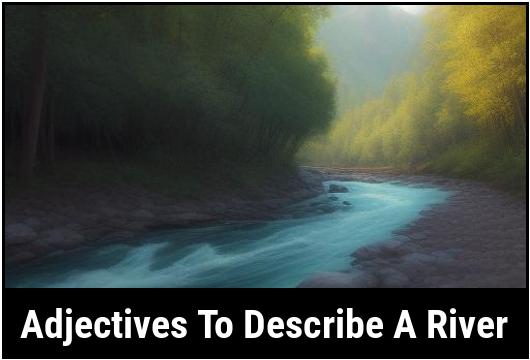- You are here:
- Home »
- adjectives
- » 31 Adjectives To Describe A River

31 Adjectives To Describe A River
Rivers are majestic and dynamic natural features that have captivated humans for centuries. They flow through diverse landscapes, shaping the earth and providing life to countless organisms. Describing a river using adjectives can help convey its beauty, power, and characteristics. From tranquil and meandering to turbulent and expansive, there are various adjectives to capture the essence of a river. In this article, we will explore the importance of using adjectives to describe rivers, how to choose the right adjectives, and the various types of adjectives that can be used to paint a vivid picture of a river’s splendor.
Rivers are essential components of the earth’s hydrological cycle, serving as vital arteries that transport water, nutrients, and sediment across the landscape. They hold significant cultural, economic, and ecological value, often serving as sources of inspiration, livelihood, and habitats for diverse flora and fauna. Describing a river using adjectives allows us to convey its diverse characteristics, evoking imagery and emotions that capture the essence of this natural wonder.
Key Takeaways
- Rivers are diverse natural features that can be characterized by a wide range of adjectives.
- Describing a river using adjectives helps to convey its beauty, power, and unique characteristics.
- Adjectives can evoke imagery and emotions that capture the essence of a river’s splendor.
- The choice of adjectives should be guided by the specific characteristics and qualities of the river being described.
Adjectives To Describe A River
1. Majestic
Rivers often command a sense of awe and wonder with their grandeur and majestic presence. Their powerful flow and vastness captivate our senses, leaving us mesmerized by their sheer beauty.
2. Serene
Some rivers embody a calm and peaceful demeanor. They flow gently, gliding across landscapes with an almost tranquil grace, creating a serene atmosphere that is perfect for relaxation and reflection.
3. Turbulent
Contrasting the serenity of some rivers, others exhibit a more forceful and turbulent nature. These rivers rush and roar, crashing against rocks and creating rapids and cascades that excite and thrill adventurous souls.
4. Pristine
Many rivers possess an untouched and pristine quality, with crystal-clear waters that reflect the surrounding landscape. These idyllic rivers are a testament to the purity and raw beauty of nature, making us appreciate the unspoiled wonders of the earth.
5. Sinuous
Some rivers meander through the land, weaving and winding their way with a graceful and sinuous flow. Their curves and bends create a mesmerizing sight, as if the river itself is a work of art, painting a breathtaking picture across the terrain.
6. Lively
Rivers are teeming with life, providing a vibrant environment for a rich diversity of plants and animals. They buzz with activity as creatures both big and small thrive in the nourishing waters, adding an element of liveliness to the entire ecosystem.
7. Enchanting
Stepping beside a river often feels like entering a magical realm. The soothing sounds of flowing water, combined with the lush greenery that lines its banks, create an enchanting atmosphere that transports us to a world of beauty and wonder.
8. Sustaining
Rivers are a lifeline for countless communities and ecosystems around the globe. They provide water for irrigation, drinking, and bathing, ensuring the survival and well-being of various species, including humans. Their sustaining nature is truly remarkable.
9. Breathtaking
The scenery surrounding rivers often takes our breath away. Majestic mountains, stunning cliffs, or verdant forests form a stunning backdrop that enhances the river’s allure, making it an irresistibly breathtaking sight.
10. Invigorating
There is something invigorating about being near a river. The crisp and fresh air, the invigorating sound of flowing water, and the sense of freedom that comes from its unrelenting movement serve as a revitalizing force, rejuvenating our spirits.
11. Nurturing
Rivers are not just vital for humans and diverse ecosystems; they also play a nurturing role for plants, helping them grow and flourish. The rich sediments they carry provide essential nutrients, supporting lush vegetation along their banks.
12. Graceful
Rivers possess an inherent gracefulness as they carve their path through the landscape. The way they navigate obstacles and effortlessly flow around curves showcases their elegant and nimble nature, akin to a graceful dancer.
13. Magnificent
Their vastness and power make rivers truly magnificent. Seeing the colossal volume of water rushing along, creating mighty rapids and waterfalls, is a sight that instills a sense of awe and admiration for the extraordinary forces of nature.
14. Dynamic
Rivers are dynamic entities, constantly in motion and ever-changing. They adapt to varying terrains, altering their course and speed, making them a fascinating force that shapes the landscape and adapts to the environment around them.
15. Timeless
Rivers have stood the test of time, carving out valleys and canyons over centuries. They serve as lasting reminders of the perseverance and endurance of nature, an eternal presence that continues to shape the face of the earth.
16. Harmonious
Rivers effortlessly blend into their surroundings as if they are a natural extension of the landscape. They harmonize with the environment and create a seamless connection between the water and the land, exemplifying a perfect balance.
17. Explorative
Rivers invite exploration and adventure, tempting us to follow their course and unravel the mysteries they hold. Whether by boat, kayak, or simply walking along their banks, rivers provide a sense of exploration and discovery at every turn.
18. Inspirational
The beauty and vitality of rivers have inspired countless artists, writers, and poets throughout history. Their ever-changing nature and incredible ecosystems are a wellspring of inspiration, sparking creativity and igniting the imagination.
19. Transformative
Rivers have the power to change landscapes and reshape the earth. They can carve canyons, create deltas, and shape coastlines, leaving a lasting mark on the world and reminding us of the transformative forces at play.
20. Transparent
Many rivers possess a transparency that allows us to see deep into their depths. This clarity unveils a world hidden beneath the water’s surface, revealing the intricate dance of fish, plant life, and submerged wonders that exist within.
21. Playful
Some rivers exude a playful nature, inviting us to participate in their spills and thrills. Whether it’s floating along the current, swimming in natural pools, or enjoying water sports, these rivers offer endless opportunities for fun and exhilaration.
22. Verdant
The lush vegetation that flourishes along river banks transforms them into verdant corridors of life. These green oases are teeming with plant species, lending an enchanting aura to the river’s surroundings and creating a haven for fauna.
23. Ancient
Rivers carry with them the weight of time, often having witnessed civilizations rise and fall, and even becoming the cradle of human development. Flowing for thousands of years, they hold the secrets of the past, connecting us to ancient histories.
24. Tranquil
Many rivers possess a tranquil and calm presence that evokes feelings of peace and serenity. The gentle flow of water and the soothing sounds they emit create a tranquil atmosphere, perfect for escaping the chaos of daily life.
25. Harmonizing
Rivers are known for their harmonizing effect, bringing diverse life forms together in a shared ecosystem. They connect various habitats and allow for species to intermingle, fostering an environment of harmony and cooperation.
26. Mysterious
Rivers often hold an air of mystery, as they hide hidden depths, secret coves, and unseen paths. There is an excitement in not knowing what lies beneath the water’s surface, sparking our curiosity and inviting us to explore their hidden wonders.
27. Reflective
Rivers, especially the calm ones, serve as reflective surfaces, mirroring the world around them. They allow us to gaze upon our own image, offering a chance for introspection and self-reflection as we contemplate the flowing currents of our lives.
28. Rhythmic
Rivers possess a natural rhythm, as the water ebbs and flows along its course. This rhythmic quality brings a sense of comfort and order, evoking a feeling of connection to the cyclical dance of life.
29. Powerful
The immense power of a river cannot be understated. It has the ability to shape landscapes, erode mountains, and generate energy. It serves as a reminder of the immense forces at work in the natural world, demonstrating the strength and resilience of nature.
30. Teeming
Rivers are teeming with life, supporting a diverse array of aquatic species. Fish, amphibians, and countless invertebrates inhabit these waters, creating a bustling and thriving ecosystem, teeming with activity and brilliant colors.
31. Freeing
Being near a river often elicits a sense of freedom and liberation. The unhindered flow of water and the innate connection to nature instill a feeling of liberation, freeing our minds from the constraints of everyday life and allowing us to embrace a sense of freedom.
Why Use Adjectives To Describe A River
Adjectives play a critical role in conveying the sensory experiences and emotional impact of natural landscapes. When it comes to rivers, adjectives offer a means of capturing the essence of these dynamic water bodies, allowing us to express their visual, auditory, and even tactile qualities. By using adjectives, we can transport the reader or listener to the banks of a river, allowing them to envision its flow, feel its energy, and appreciate its unique traits.
Describing a river using adjectives is also a powerful tool for writers, poets, and artists seeking to evoke specific moods or themes. Whether portraying a serene, reflective setting or an untamed, forceful waterway, adjectives enable creators to infuse their work with vivid imagery and emotional depth. By employing the right adjectives, one can transform a mere description into a compelling portrayal that resonates with the audience.
How To Choose The Right Adjective To Describe A River
When selecting adjectives to describe a river, it is essential to consider the specific characteristics and qualities of the river in question. Factors such as its flow, size, surroundings, and ecosystem can all influence the choice of adjectives. Additionally, the intended emotional or sensory impact should guide the selection of adjectives to create a vivid and evocative description. The following considerations can help in choosing the right adjectives:
-
Observation and Sensory Experience: Start by observing the river and considering the sensory experiences it evokes. Does it inspire a sense of tranquility, power, or grandeur? What sounds, sights, and scents are associated with the river? This sensory input can guide the selection of adjectives that effectively capture these qualities.
-
Understanding the River’s Characteristics: Consider the river’s physical attributes, such as its width, depth, speed, and meandering patterns. Is it a placid, meandering stream, or a fast-flowing, turbulent river? Understanding these characteristics will inform the choice of adjectives that accurately depict its nature.
-
Emotional Impact: Think about the emotional response you want to elicit from the audience. Are you aiming to convey a sense of serenity, power, mystery, or awe? By identifying the desired emotional impact, you can select adjectives that align with these thematic intentions.
-
Context and Surroundings: Take into account the surrounding environment, including the riverbanks, flora, fauna, and adjacent landscapes. The interplay between the river and its surroundings can inspire adjectives that reflect the interconnectedness of the ecosystem and its visual allure.
-
Creative Expression: For artistic or literary purposes, consider how the chosen adjectives contribute to the overall mood, symbolism, or narrative of the piece. Adjectives can be used to convey metaphors, allegories, or abstract concepts, adding depth and richness to the portrayal of the river.
Types Of Adjectives For Describing A River
Adjectives used to describe rivers can encompass a wide range of qualities and characteristics, reflecting the diverse nature of these water bodies. From serene and picturesque to tumultuous and formidable, the following types of adjectives can effectively capture the essence of a river:
-
Physical Attributes:
- Wide: Describing a river as wide emphasizes its expansiveness and the breadth of its flow.
- Narrow: This adjective denotes a river’s limited width, implying intimacy and possibly constraint.
- Deep: Describing a river as deep highlights its profound depth and often conveys a sense of mystery and magnitude.
-
Flow and Movement:
- Meandering: This adjective evokes the image of a gentle, winding river, emphasizing its leisurely and curving course.
- Rapid: Describing a river as rapid accentuates its swift and energetic flow, often denoting intensity and power.
- Calm: This adjective portrays a river with a tranquil and peaceful flow, emphasizing its quiet and serene nature.
-
Emotional and Sensory Impact:
- Majestic: Describing a river as majestic emphasizes its grandeur and awe-inspiring presence, often evoking a sense of reverence and admiration.
- Mysterious: This adjective suggests an enigmatic and intriguing quality, adding an element of fascination and curiosity to the river’s depiction.
- Invigorating: Describing a river as invigorating conveys its energizing and revitalizing effect, evoking a sense of vitality and dynamism.
-
Surroundings and Ecosystem:
- Lush: This adjective emphasizes the verdant and abundant vegetation that adorns the riverbanks and surrounding landscape.
- Teeming: Describing a river as teeming underscores the abundance of life and activity within its ecosystem, conveying a sense of vitality and diversity.
- Scenic: This adjective highlights the visual beauty and picturesque nature of the river and its surroundings, evoking images of captivating landscapes.
-
Symbolism and Metaphor:
- Eternal: Describing a river as eternal conveys a timeless and enduring quality, often employed to denote continuity and permanence.
- Vital: This adjective emphasizes the river’s indispensable role in sustaining life and ecosystems, portraying it as essential and life-giving.
- Boundless: Describing a river as boundless captures its seemingly limitless expanse, symbolizing freedom and uncontained energy.
The use of adjectives to describe a river offers a powerful means of conveying its myriad qualities and characteristics. By judiciously selecting adjectives that align with the sensory experiences, emotional impact, and thematic intentions, one can create a vivid and evocative portrayal of a river’s splendor. Whether capturing its physical attributes, expressive movements, emotional resonance, or symbolic significance, adjectives serve as indispensable tools for conveying the essence of these dynamic water bodies. Through the artful selection of adjectives, one can guide the audience to appreciate the beauty, power, and significance of rivers, ensuring that their enchanting allure is vividly captured in both literature and everyday discourse.
Examples Of Adjectives For Different Types Of Rivers
Describing a river can be a challenging task. It requires the writer to paint a vivid picture of the river’s characteristics and evoke the reader’s senses. One effective way to create a descriptive and engaging river description is by using adjectives.
Adjectives are words that modify or describe nouns, providing additional information about their qualities, features, or characteristics. In the context of describing a river, adjectives can be used to capture its appearance, size, flow, surroundings, and even its emotional impact.
-
Mighty River: Use this adjective when describing a large and powerful river. For example, the Amazon River is a mighty river that flows through South America.
-
Serene River: This adjective is suitable for describing a calm and peaceful river. The Serengeti River gently meanders through the African plains, creating a serene atmosphere.
-
Raging River: This adjective is used to describe a river that is fierce and turbulent. The Colorado River transforms into a raging river as it rushes through the Grand Canyon.
-
Crystal-clear River: Use this adjective to describe a river with perfectly transparent water. The crystal-clear rivers of Iceland showcase the pristine beauty of nature.
-
Winding River: This adjective is apt for describing a river that twists and turns along its course. The Mississippi River is known for its winding path through several U.S. states.
-
Ethereal River: This adjective is used to describe a river that seems otherworldly or dreamlike in its appearance. The ethereal Ganges River in India holds deep spiritual significance for many.
-
Majestic River: Use this adjective to describe a river that commands awe and admiration due to its grandeur. The Nile River, with its historical importance and vastness, is often referred to as a majestic river.
-
Turquoise River: This adjective is applicable when describing a river with a vibrant blue-green color. The Verzasca River in Switzerland is famous for its turquoise waters.
-
Gentle River: This adjective is suitable for describing a river with a mild and placid flow. The gentle Ouse River in England offers a serene setting for leisurely cruises.
-
Enchanting River: Use this adjective to describe a river that captivates and enchants with its beauty. The Danube River, flowing through several European countries, is an enchanting river that has inspired many artists and composers.
These examples demonstrate how adjectives can add depth and evoke specific emotions when describing different types of rivers. Adjectives help the reader visualize and feel the river’s essence, creating a more engaging reading experience.
Common Mistakes In Using Adjectives To Describe A River
When using adjectives to describe a river, there are some common mistakes to be aware of. Avoiding these errors will help ensure a more accurate and effective description of the river:
-
Overuse of generic adjectives: Using generic adjectives like "beautiful" or "nice" can make the description of a river sound vague and uninteresting. Instead, try to use more specific and evocative adjectives that provide a clear image of the river’s attributes.
-
Using adjectives that don’t fit the river: It’s important to choose adjectives that accurately reflect the characteristics of the river. For example, describing a calm and gentle river as "wild" would create a contradiction and confuse the reader.
-
Lack of variety: Using the same adjectives repeatedly can make the description monotonous. Instead, strive to vary the adjectives throughout the description to add richness and depth.
-
Neglecting sensory adjectives: Describing a river solely in terms of its appearance can limit the reader’s experience. Including sensory adjectives that evoke the sounds, smells, and textures associated with the river can make the description more immersive.
By being mindful of these common mistakes, you can ensure that your description of a river is accurate, engaging, and effective.
Using Adjectives Effectively
To make the most of adjectives when describing a river, consider the following tips:
-
Be specific: Instead of using vague adjectives, opt for specific ones that vividly capture the river’s features. For example, instead of describing a river as "beautiful," you could use "pristine," "picturesque," "idyllic," or "breathtaking."
-
Paint a multisensory picture: Engage the reader’s senses by incorporating adjectives that describe the river’s sounds, smells, and textures. For example, instead of solely describing the river’s appearance, you could add adjectives like "rippling," "echoing," "fragrant," or "velvety" to create a more immersive experience.
-
Consider the emotional impact: Adjectives can help convey the emotional impact a river may have on the observer. For instance, you might describe a river as "invigorating," "peaceful," "captivating," or "awe-inspiring" to evoke different emotions.
-
Contextualize the adjectives: When using adjectives, ensure they make sense within the context of the river’s surroundings. For example, describing a river in a lush tropical rainforest as "arid" would be inconsistent and confusing.
-
Practice imagery: Use descriptive adjectives that create vivid mental images in the reader’s mind. This can be achieved by choosing adjectives that paint pictures and appeal to the reader’s imagination. For instance, instead of saying a river is "wide," you could say it is "expansive like a flowing mirror."
By following these tips, you can effectively use adjectives to create a captivating and evocative description of a river.
Exercises And Practice
To enhance your skills in using adjectives to describe a river, consider the following exercise:
-
Choose a river: Select a river that you find interesting or have personal experience with. It could be a river you have visited, seen in photographs, or read about.
-
Brainstorm adjectives: Make a list of adjectives that come to mind when you think about the river. Start by noting down adjectives related to visual characteristics, such as color, size, or shape. Then expand your list to include adjectives related to the river’s flow, surroundings, and emotional impact.
-
Refine and categorize: Review your list of adjectives and refine it by removing any generic or repetitive ones. Then categorize the adjectives based on the river’s appearance, flow, surroundings, and emotional impact.
-
Compose a descriptive paragraph: Using the refined and categorized list of adjectives, write a descriptive paragraph about the river. Ensure that the paragraph paints a vivid picture of the river and evokes a sense of its essence.
-
Share and receive feedback: Share your descriptive paragraph with others and ask for their feedback. Consider their suggestions for improvement and revise your paragraph accordingly.
Repeatedly practicing this exercise with different rivers will help you develop your skill in using adjectives effectively in river descriptions.
Conclusion
Describing a river with precision and emotion can be accomplished by effectively using a variety of adjectives. By choosing specific and descriptive adjectives, you can create a compelling image of the river in the reader’s mind. Additionally, incorporating sensory adjectives and considering the emotional impact of the river will enhance the overall descriptive experience.
Avoid common mistakes such as overusing generic adjectives and neglecting sensory details. Instead, strive to be specific, paint a multisensory picture, and choose adjectives that fit both the river and its surroundings. Remember, practice is key to mastering the art of using adjectives to describe a river. So, get creative, keep practicing, and soon you’ll be able to effortlessly craft vivid and engaging descriptions of rivers.
FAQS On Adjectives To Describe A River
What Are Some Common Adjectives Used To Describe A River?
Some common adjectives used to describe a river are serene, rushing, meandering, turbulent, and majestic.
How Can A River Be Described As Serene?
A serene river is one that is peaceful and calm, with gentle flowing water and a tranquil atmosphere.
What Are Some Characteristics Of A Rushing River?
A rushing river is characterized by fast-moving, forceful water that is often loud and energetic. It may also have rapids and white water.
How Is A Meandering River Different From Other Rivers?
A meandering river is one that follows a winding, curvy path and often has slower-moving water. It may also create loop-like bends and oxbow lakes along its course.
What Does It Mean For A River To Be Described As Turbulent?
A turbulent river is one that has rough, churning water due to obstacles such as rocks or changes in elevation. It may also have strong currents and be difficult to navigate.
What Makes A River Majestic?
A majestic river is one that has a grand, awe-inspiring presence. It may be large in size, have breathtaking views, or hold cultural or historical significance.








